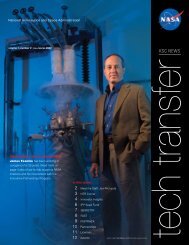2006-2007 - Kennedy Space Center Technology Transfer Office
2006-2007 - Kennedy Space Center Technology Transfer Office
2006-2007 - Kennedy Space Center Technology Transfer Office
- No tags were found...
Create successful ePaper yourself
Turn your PDF publications into a flip-book with our unique Google optimized e-Paper software.
Numerical Analysis of Rocket Exhaust Cratering<strong>2007</strong> <strong>Center</strong> Director’s Discretionary Fund ProjectSupersonic jet exhaust impinging onto a flat surface is a fundamental flow encounteredLunar Launch/Landing Site in space or with a missile launch vehicle system. The flow is important because it canEjecta Mitigation endanger launch operations. The purpose of this study is to evaluate the effect of alanding rocket’s exhaust on soils. From numerical simulations and analysis, we developedcharacteristic expressions and curves, which we can use, along with rocket nozzle performance, topredict cratering effects during a soft-soil landing.We conducted a series of multiphase flow simulations with two phases: exhaust gas and sandparticles. The gas expanded from the nozzle exit with a prescribed velocity profile and impinged ontothe sand surface. The interaction between those two phases formed the erosion on the sand bed.The results enabled use to describe the basic effects of gas jets impinging on sand and to relate craterdimensions to the soil characteristics and the numerical simulation parameters, including volumefraction, packing limit, and angle of internal friction.The main objective of the simulation was to obtain the numerical results as close to the experimentalresults as possible. After several simulating test runs, the results showed that packing limit and theangle of internal friction are the two critical and dominant factors in the simulations. Our workincluded• reviewing numerical and experimental studies related to multiphase, supersonic flow,• performing axisymmetric and 3-D supersonic flow impingement,• comparing two-phase flow numerical results with experimental data,• implementing a new user-defined function to model the nozzle boundary condition,• presenting the study at the AIAA Fluid Dynamics conference, and• delivering validated numerical solutions with a final report.Contact: Dr. Bruce T. Vu , NASA-KSC, (321) 867-2376Participating Organization: Florida Institute of <strong>Technology</strong> (Dr. Pei-feng Hsu)34 <strong>Space</strong>port Structures and Materials













